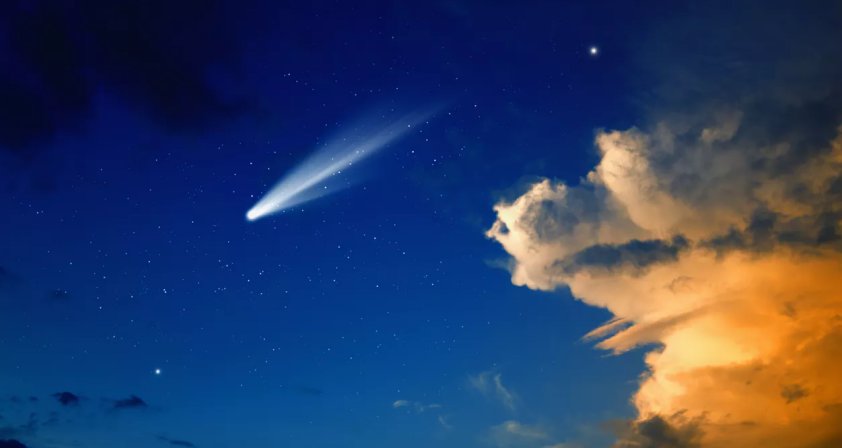How Ancient Cultures Explained Comets And Meteors
AncientPages.com - Comets and meteors have fascinated the human race since they were first spotted in the night sky. But without science and space exploration to aid understanding of what these chunks of rock and ice are, ancient cultures often turned to myth and legend to explain them.
Credit: Public Domain
The Greeks and Romans believed that the appearance of comets, meteors and meteor showers were portentous. They were signs that something good or bad had happened or was about to happen. The arrival of a comet could herald the birth of a great figure, and some people have even argued that the star in the sky which the Persian Magi followed to Bethlehem to see the newborn Jesus was actually a comet.
In the spring of 44BC, a comet that appeared was interpreted as a sign of the deification of Julius Caesar, following his murder. Caesar’s adopted son Octavian (soon to be the Emperor Augustus) made much of the comet, which burned in the sky during the funerary games held for Caesar. This portentous event was frequently celebrated in the ancient sources. In his epic poem, the Aeneid, Virgil describes how “a star appeared in the daytime, and Augustus persuaded people to believe it was Caesar”.
Caesar’s comet, depicted on a denarius coin. Credit: Public Domain, Wikimedia/Classical Numismatic Group, Inc., CC BY-SA
Augustus celebrated the comet and the deification of his father on coins (it did help to be the son of a god when trying to rule the Roman Empire), and many examples survive today.
Meteor showers
The Roman historian Cassius Dio referred to “comet stars” occurring in August 30BC. These are mentioned as among the portents witnessed after the death of the Egyptian queen Cleopatra. Experts are not entirely sure what it means when Dio uses the plural term “comet stars”, but some have connected this recorded event to the annual Perseid meteor shower.
Though it retains an ancient Greek name, we now know that the arrival of the Perseid meteor shower every August is actually the Earth’s orbit passing through debris from the Swift-Tuttle comet.
The meteor shower is named for the Perseidai (Περσείδαι), who were the sons of the ancient Greek hero Perseus. Perseus was a legendary figure with a fine family pedigree – he was the mythical son of Zeus and Argive princess Danaë (she of the golden rain). Perseus earned himself a constellation after a number of epic adventures across the Mediterranean and Near East that included the frequently illustrated murder of the Gorgon sister, Medusa.
Perseus flees after cutting off Medusa’s head in this water jar depiction. British Museum, CC BY-NC-SA
Another of Perseus’s celebrated acts was the rescue of the princess Andromeda. Abandoned by her parents to placate a sea monster, the princess was found by Perseus on a rock by the ocean. He married her and they went on to have seven sons and two daughters. Sky watchers believed that the constellation Perseus, located just beside Andromeda in the night sky, was the origin of the shooting stars they could see every summer, and so the name Perseid stuck.
Tears And Other Traditions
In Christian tradition the Perseid meteor shower has long been connected to the martyrdom of St Lawrence. Laurentius was a deacon in the early church at Rome, martyred in the year 258 AD, during the persecutions of the Emperor Valerian. The martyrdom supposedly took place on August 10, when the meteor shower was at its height, and so the shooting stars are equated to the saint’s tears.
Wall painting from Pompeii, representing Perseus rescuing Andromeda. Wikimedia, CC BY-SA
Detailed records of astronomical events and sky watching can be found in historical texts from the Far East too. Ancient and medieval records from China, Korea and Japan have all been found to contain detailed accounts of meteor showers. Sometimes these different sources can be correlated, which has allowed astronomers to track, for example, the impact of Halley’s comet on ancient societies both east and west. These sources have also been used to find the first recorded observation of the Perseid meteor shower as a specific event, in Han Chinese records of 36AD.
See also:
Moon: What Was Its Role In Beliefs Of Ancient People?
Full Moon In Ancient Myths And Legends Of Our Ancestors
Sun: Highest Cosmic Power Worshiped By Ancient People And Represented By Deities
Though the myths and legends may make one think that ancient civilisations had little scientific understanding of what meteors, comets and asteroids could be, this couldn’t be farther from the truth. The early astronomers of the Near East, those who created the Babylonian and Egyptian calendars, and astronomical data were – by far – the most advanced in antiquity. And a recent study of ancient cuneiform texts has proven that the Babylonian ability to track comets, planetary movements and sky events as far back as the first millennium BC involved a much more complex geometry than had been previously believed.
Written by Eve MacDonald - Lecturer in Ancient History, Cardiff University
This article is republished from The Conversation under a Creative Commons license. Read the original article.
More From Ancient Pages
-
 Frightening Legend Of Tate’s Hell Swamp And The Curse Of The Native American Medicine Man
Featured Stories | Feb 12, 2022
Frightening Legend Of Tate’s Hell Swamp And The Curse Of The Native American Medicine Man
Featured Stories | Feb 12, 2022 -
 Mysterious Lost Tartessian Civilization And Its Ancient Tablet With Paleo-Hispanic Alphabet
Archaeology | Jun 15, 2024
Mysterious Lost Tartessian Civilization And Its Ancient Tablet With Paleo-Hispanic Alphabet
Archaeology | Jun 15, 2024 -
 Secrets Of The Famous Hellenistic-Era Kyrenia Shipwreck Revealed
Archaeology | Jun 28, 2024
Secrets Of The Famous Hellenistic-Era Kyrenia Shipwreck Revealed
Archaeology | Jun 28, 2024 -
 Collapse Of Akkadian Empire Strongly Related To Catastrophic Climate Change
Archaeology | Oct 28, 2019
Collapse Of Akkadian Empire Strongly Related To Catastrophic Climate Change
Archaeology | Oct 28, 2019 -
 Mysterious Underground City In Brazil Could Re-Write Ancient History – Unexplained Artifacts And Skeletons – Part 1
Ancient Mysteries | Jan 23, 2022
Mysterious Underground City In Brazil Could Re-Write Ancient History – Unexplained Artifacts And Skeletons – Part 1
Ancient Mysteries | Jan 23, 2022 -
 Ur-Nammu – Popular And Accomplished Ruler Of Sumer
Civilizations | Oct 31, 2016
Ur-Nammu – Popular And Accomplished Ruler Of Sumer
Civilizations | Oct 31, 2016 -
 Remains Of Medieval Port Discovered In Eindhoven
Archaeology | Nov 17, 2020
Remains Of Medieval Port Discovered In Eindhoven
Archaeology | Nov 17, 2020 -
 Mysterious Mount Kailash: Secrets Of The Man-Made Pyramid And Entrance To The City Of The Gods
Ancient Mysteries | Oct 27, 2014
Mysterious Mount Kailash: Secrets Of The Man-Made Pyramid And Entrance To The City Of The Gods
Ancient Mysteries | Oct 27, 2014 -
 Why Didn’t Pythagoras And His Followers Eat Beans?
Ancient History Facts | Jan 18, 2019
Why Didn’t Pythagoras And His Followers Eat Beans?
Ancient History Facts | Jan 18, 2019 -
 Puzzling McClelland Sherd – Undeciphered Inscription Could Be Early Bronze Age Writing
Artifacts | Mar 27, 2018
Puzzling McClelland Sherd – Undeciphered Inscription Could Be Early Bronze Age Writing
Artifacts | Mar 27, 2018 -
 On This Day In History: Anders Celsius, Swedish Astronomer And Mathematician Was Born – On Nov 27, 1701
News | Nov 26, 2016
On This Day In History: Anders Celsius, Swedish Astronomer And Mathematician Was Born – On Nov 27, 1701
News | Nov 26, 2016 -
 Medieval Burial Mystery: Enigma Of Missing Bones Of The Venerable Bede
News | Sep 10, 2015
Medieval Burial Mystery: Enigma Of Missing Bones Of The Venerable Bede
News | Sep 10, 2015 -
 Numa Pompilius – Remarkable Legendary Second King Of Ancient Rome Who Succeeded Romulus – Did He Ever Exist?
Featured Stories | Mar 2, 2018
Numa Pompilius – Remarkable Legendary Second King Of Ancient Rome Who Succeeded Romulus – Did He Ever Exist?
Featured Stories | Mar 2, 2018 -
 Ruins Of A Roman-Era Bath And A Floor Mosaic Discovered In Central Anatolia
Archaeology | Dec 28, 2015
Ruins Of A Roman-Era Bath And A Floor Mosaic Discovered In Central Anatolia
Archaeology | Dec 28, 2015 -
 On This Day In History: Unua Libro ‘First Book’ Describing Esperanto Published – On July 26, 1887
News | Jul 26, 2016
On This Day In History: Unua Libro ‘First Book’ Describing Esperanto Published – On July 26, 1887
News | Jul 26, 2016 -
 Beautiful Neolithic Ornate Necklace With Over 2,500 Stones Found In A Child’s Grave
Archaeology | Aug 2, 2023
Beautiful Neolithic Ornate Necklace With Over 2,500 Stones Found In A Child’s Grave
Archaeology | Aug 2, 2023 -
 Thousands Of Sacred ‘Images’ With Unknown Signs Hidden In A Monastery Could Be World’s Oldest Alphabet
Ancient Mysteries | Jun 9, 2021
Thousands Of Sacred ‘Images’ With Unknown Signs Hidden In A Monastery Could Be World’s Oldest Alphabet
Ancient Mysteries | Jun 9, 2021 -
 What Is The Avoidance Custom Of The Amish People In Pennsylvania?
Ancient History Facts | Jul 29, 2019
What Is The Avoidance Custom Of The Amish People In Pennsylvania?
Ancient History Facts | Jul 29, 2019 -
 The Assyrian Siege Ramp And Breached Walls At Canaanite City Of Lachish – Studied
Archaeology | Nov 10, 2021
The Assyrian Siege Ramp And Breached Walls At Canaanite City Of Lachish – Studied
Archaeology | Nov 10, 2021 -
 Sanctuary Of Amarysia Artemis, Amarynthos – New Valuable Finds By Greek-Swiss Team
Archaeology | Sep 26, 2022
Sanctuary Of Amarysia Artemis, Amarynthos – New Valuable Finds By Greek-Swiss Team
Archaeology | Sep 26, 2022




